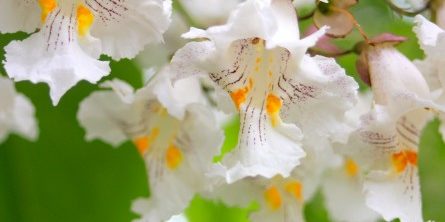THE LEAFLET

Tree of the Month: Catalpa
‘You know, that cigar tree…’ is a very common refrain, usually followed by that often all-knowing nod. But they aren’t really cigars! The familiar string-bean like fruit capsule, paired with the large green heart shaped leaf unmistakably distinguishes our familiar and ubiquitous native Catalpa tree from other common trees with similar cordate-shaped leaves, such as the redbud, linden or the princess paulownia.
Unbeknownst to many, however, is that there are actually two native catalpa species, whose ranges overlap here in the mid-Atlantic area. We have both the northern catalpa, Catalpa speciosa, and the common or southern catalpa, Catalpa bignonioides. Most of the distinctions between them are quite subtle, the northern tending to be a larger tree, with larger leaves, the southern tending to have more speckles of orange and purple throughout the prolific white blossoms. But to know for sure – and you can try this at home! – crush a leaf or two, or crack open a seed pod: the southern catalpa has a strong, foul odor when crushed; and the seed pods have little hairs (beards!) that come to a point at each end. The northern does not.
Michael Dirr, author of the botanical bible Manual of Woody Landscape Plants, aptly characterizes the catalpa growth habit as “narrow, open, irregular, oval grown; can be quite striking in winter with bold rugged outline.” But he qualifies his admiration for the tree “limited value in the residential landscape because of coarseness; has a place in difficult areas but the use of this … should be tempered.”

For some additional perspectives, we turned to Richard Olsen, research scientist at the National Arboretum and perhaps the catalpa’s biggest champion in the mid-Atlantic region. He runs experimental trials on various crosses of different catalpas out at his Greenbelt research plots, with an eye for selecting individuals with more or less of certain characteristics.
We asked Richard what fascinates him about the Catalpa.
“Despite bad horticultural press, the trees are extremely resilient; yes they drop flowers, pods, and large leaves, but what tree doesn’t drop some litter? Oaks are tremendously messy, yet they are forgiven each year for their large crops of acorns and constant shedding of pin branches!
“Catalpas are a true ecosystem until themselves. Their orchid-like flowers, which last 10 or 12 days, are visited by pollinating bumblebees and nectar-thieving insects. The leaves possess extra-floral nectaries, which secrete sugar nectar as a reward for roving bands of ants that defend the leaves from chewing insects. And if you are into fishing, catalpas are the sole host for our catalpa sphinx moth caterpillar, a large black caterpillar with yellow and white stripes, that are relished by largemouth bass.”
“Catalpas, along with trumpet creeper (Campsis radicans) and cross vine (Bignonia capreolata), are North America’s northern most representatives of a primarily tropical family, a reminder that our flora has evolved from a once widespread mixed forest of broad-leaved evergreens from a warmer period in our planet’s history. You can still find evergreen catalpa species in the West Indies which provides a living link across millions of years of evolution.”
Where and when to find them?
Melanie Chukas Bradley also cheers for the Catalpa in her City of Trees: “The catalpas are among Washington’s most beautiful flowering trees. … Because the catalpas are full-sized trees and bloom at a time when they pretty much have the scene to themselves, their effect in flower is dramatic.”
Though both native species are quite commonly occurring throughout Washington, DC, Melanie notes several prominent locations where the different species can be found:
Northern catalpa – Catalpa speciosa: corner of E and First St, SE;
Common catalpa – Catalpa bignonioides: Washington monument grounds
Yellow/Chinese catalpa – Catalpa ovata: though less common, can also be spotted on the Washington Monument grounds, as well as the Tidal Basin, and the National Zoo.
During the heat of the summer, be sure to seek out the deep dark shade of any of our many Catalpa or cawtawba, as the Native Americans originally called it.